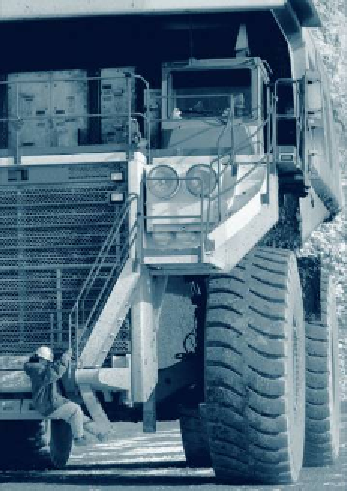Environmental Engineering Reference
In-Depth Information
FIGURE 22.1
The Trend of Ever Larger Haulage Trucks
Despite the lower grades and higher stripping ratios the lower haulage
costs and similar economies of scale in milling and treatment processes
have reduced the cost in real terms of production of many mineral
commodities.
Photo Credit: Jerilee Bennett, The Gazette
mines. For some metals, 90% of production is sourced from 5% of the mines. Much of this
phenomenon relates to economies of scale which apply particularly to surface mines. Most
of this is the result of using ever larger haulage trucks (
Figure 22.1
). In the early 1970s a
haulage truck of 50-tonne capacity was considered large, while 30 years later 350-tonne
trucks are widely used in larger mining operations; and it may not be long before 500-
tonne trucks are common. Lower bulk haulage costs have had two marked effects:
●
For some metals, 90% of
production is sourced from 5%
of the mines.
They enable much lower grade deposits to be economically mined. (Average grades of
copper ores mined today are, in many cases, lower than cutoff grades 40 years ago).
●
They allow much higher stripping ratios, which means that deeper mineral depos-
its which were previously uneconomic, can now be economically mined by open pit
methods.
Despite the lower grades and higher stripping ratios, however, the lower haulage costs and
similar economies of scale in milling and treatment processes have reduced the cost, in real
terms, of production of many mineral commodities. This is the main reason that, recent
price rises notwithstanding, the price of commodities such as copper has declined progres-
sively over the past century, as shown in
Figure 22.2
.
As a consequence of this trend, ore that would previously have been mined underground,
if at all, is now being extracted in surface mines. At the same time, much more of the
resource is now being used; previously, most underground mining extracted only the high-
grade ore, leaving much more extensive lower grade mineralization which, in many cases,
contained more minerals than the high-grade ores. A good example of this is the Super Pit
near Kalgoorlie in the Western Australian Goldi elds, where high-grade gold ores were
mined by underground methods for many decades. Subsequently, a large open pit was
developed to extract the low-grade ores that surrounded the high-grade mineralization.
One of the consequences of this trend toward very large mining operations is that pro-
duction is being concentrated among a few, very large mining companies, as these are the
only entities that can access the huge capital required to develop such projects. The largest
operations are often jointly owned by two or more companies.
One of the consequences of this
trend toward very large mining
operations is that production is
being concentrated among a few,
very large mining companies.











Search WWH ::

Custom Search